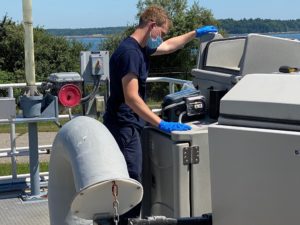 “The sewer is the conscience of the city.” Phyllis Rand, of the Greater Augusta Utility District, shared this quote from Victor Hugo’s “Les Misérables” during a recent training on wastewater-based epidemiology. Rand emphasized how pollutants, diseases, and other materials in our wastewater are valuable data that tell stories about a community.
“The sewer is the conscience of the city.” Phyllis Rand, of the Greater Augusta Utility District, shared this quote from Victor Hugo’s “Les Misérables” during a recent training on wastewater-based epidemiology. Rand emphasized how pollutants, diseases, and other materials in our wastewater are valuable data that tell stories about a community.
In the last two years, water flushed down the drain has been providing researchers and public health officials important insights into the spread of the coronavirus. Not only can wastewater provide a snapshot of the virus’s current prevalence in a community, but it can also help predict future cases of COVID-19.
Wastewater-based epidemiology (WBE) involves testing samples from wastewater to detect specific substances or viral fragments, and then using statistical modeling techniques to measure and predict public health trends or outcomes.
Wastewater surveillance is a relatively new field, but as the SARS-CoV-2 virus spread around the world in early 2020, so did interest in tracking the virus in wastewater. Individuals infected with SARS-CoV-2 shed the virus in their feces throughout their illness, and viral fragments remain detectable through wastewater sampling and surveillance programs for a few days. The amount of a virus an infected individual sheds can be represented in the population’s wastewater, for as long as the virus particles persist in the environment. However, the exact amount of the virus a person sheds in their fecal matter over the course of their infection is still an unknown variable.
Nevertheless, wastewater-based epidemiology has been an important public-health surveillance tool to complement traditional clinical surveillance for COVID-19. WBE can provide a more accurate understanding of the number of coronavirus cases in a community. For instance, both asymptomatic and symptomatic individuals will be detected in wastewater samples. Scientists can also use the viral concentrations in the wastewater stream and observed cases of the disease to predict future cases.
Comparing COVID-19 Cases to Wastewater Data Wastewater facilities around the world have been partnering with researchers to embark on WBE studies. Utilities in the Northeast have been eager to participate in these efforts. In 2020, the Massachusetts Water Resource Authority, which services Greater Boston, began partnering with BioBot Analytics, a wastewater epidemiology company, to analyze their influent samples for the presence of SARS-CoV-2 fragments. Likewise, the Portland Water District in Maine partnered with St. Joseph’s College to analyze their influent samples. The Greater New Haven Water Pollution Control Authority in Connecticut partnered with Yale University to analyze samples of their wastewater residuals.
In the spring of 2021, Elyssa Anneser and Emily Riseberg, two graduate students in the public health program at Tufts University, worked under the guidance of NEIWPCC Wastewater and Onsite Systems Program Director Christina Stringer, to investigate the statistical relationship between SARSCoV-2 concentrations in wastewater and COVID-19 reported cases. They evaluated the data from Boston, Portland, and New Haven using four different types of statistical regressions to model the rate of COVID-19 cases in those communities. These models — linear, generalized additive, Poisson, and negative binomial — take into account covariates that can affect the data, like temperature and flow rate in the wastewater streams. Each model represents different potential relationships between the variables.
Anneser and Riseberg verified an association between the data sets and determined which models best predicted the COVID-19 case rate based on the wastewater SARS-CoV-2 concentrations and different covariates. They found that the generalized additive and negative binomial models best represented the actual data across all three locations. The graphs on page 9 show the actual number of COVID-19 cases reported in each location and the number of cases predicted by the generalized additive regression.
While Anneser and Riseberg’s project was a secondary analysis of the data from New Haven and Boston, this was the first look at wastewater and incidence data in Portland. Anneser and Riseberg met with the Portland public health department to help develop an infographic and posters that can be used to explain WBE’s uses and benefits to the community.
In addition, this was the first project to compare different statistical analytical approaches between multiple locations among New England communities. Although more research and data are needed, this work represents a promising first step towards providing predictive models of COVID-19 cases to public health officials for decision-making purposes.
This past year has seen an immense investment in WBE and environmental surveillance. Looking ahead, WBE can be instrumental in spotting outbreaks of COVID-19 early and allow for public health intervention to break the course of transmission. WBE is also expected to be used to investigate the effectiveness of vaccines in halting the spread of COVID-19. In the future, WBE approaches may strengthen the world’s pandemic early warning system or even assist with surveillance for the annual flu.
Vaccination campaigns are in full swing around the world but challenges, like new virus variants, remain. Wastewater-based epidemiology has great potential to guide public health officials through the hopeful end of the pandemic.
This story was originally printed, with additional information, in the Fall 2021 issue of “Interstate Waters.” Written by NEIWPCC interns Elyssa Anneser and Emily Riseberg, supporting a project investigating regional biosolids generation. Kale Connerty, NEIWPCC information officer, also contributed to this article.